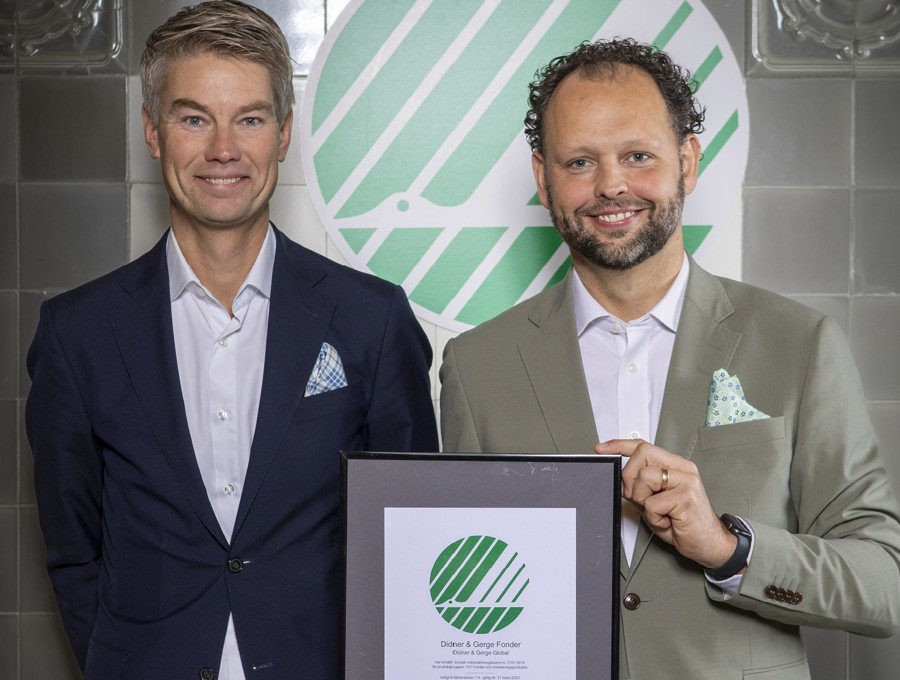Sustainable Investment Policy
The Sustainable Investment Policy for Didner & Gerge Fonder consists of many parts. Didner & Gerge Fonder AB (“the Fund Company”) was formed 18 July 1994 and was granted to authorisation to conduct fund business on 20 October 1994. At present, the company’s business comprises management of six equity funds (in Swedish). The Fund Company’s fundamental view is that a well-managed company is one that respects international norms and agreements regarding human rights, labour, the environment and corruption. Responsible and sustainable conduct is in the best interests of our unitholders and ourselves. Accordingly, we take a long-term perspective when we invest. Our constant ambition is to find companies that understand the importance of conserving resources and minimising risk.
Scope
This policy constitutes the framework for the Fund Company’s approach to responsible investment. The policy applies to all funds managed by the Fund Company and serves as a framework. Meaning that each fund and its managers are free to apply stricter sustainability criteria to investment decisions than those specified.
Our philosophy
We always act in the best interests of our fund unitholders. Asset management is a fiduciary duty – and a matter of trust. Actively managing and growing the value of our unitholders’ assets responsibly, sustainably and for the long term, is our most important task. The bedrock of our philosophy is to find well-managed companies that have stable governance and owners and sustainable business models. They should also promote and facilitate responsible fund management.
Responsible investment is important to us. Therefore we diligently seek knowledge about how the companies included in our funds work with sustainability to ensure it. We prefer companies in which sustainability is a central tenet of their strategies. Furthermore, we look for companies that take a long-term approach to sustainability work.
Didner & Gerge understands sustainability as an expansive concept that imbues the entire organisation. ESG has become a generally accepted concept in the investment industry. It is used to describe sustainability from the Environmental, Social and Governance perspectives. Didner & Gerge incorporates sustainability in fund management by obtaining relevant information about the companies in the fund portfolios and acting accordingly by means including shareholder engagement.
The UN Principles for Responsible Investment (PRI)
The Fund Company became a signatory to the UN Principles for Responsible Investment (PRI) in 2015. In becoming a signatory, the Fund Company committed to adhering to the six principles of the PRI. In brief, the six principles entail the following for the Fund Company, we will:
- Incorporate ESG issues into investment analysis and decision-making processes.
- Be active owners and incorporate ESG issues into our ownership policies and practices.
- Seek appropriate disclosure on ESG issues by the entities in which we invest.
- Promote acceptance and implementation of the Principles within the investment industry.
- Work together to enhance our effectiveness in implementing the Principles.
- Report on our activities and progress towards implementing the Principles.
For more information about what exclusion critiera we apply for our funds, look further down the page under Clarification of exclusion criteria.
The Fund Company also considers compliance with the following international norms and agreements:
- UN Global Compact
Covers ten principles in the areas of human rights, the environment, labour and anti-corruption (unglobalcompact.org). - OECD Guidelines for Multinational Enterprises
Covers issues including human rights, disclosure, employment and industrial relations, the environment, bribery and anti-corruption, consumer interests and competition (oecd.org). - ILO (International Labour Organization)
ILO is a tripartite UN agency dedicated to labour issues. The organisation’s fundamental purpose is to fight poverty and promote social justice. The organization’s mission includes promoting decent work and better working conditions worldwide and protecting the right to free association, the right to organise and the right to collective bargaining (ilo.org/global).
All companies included in our funds must comply with the standards set in these norms and agreements.
Responsible fund management
The Fund Company is an active manager that carefully selects fund holdings based on thorough company analysis. We invest in a select group of companies all over the world. Our managers devote considerable time to investigating whether companies are run by individuals of high integrity and have business models that maintain their relevance, so that we can be long-term owners. Responsible investment is important to us. Accordingly, we diligently seek in-depth knowledge about how the companies included in our funds work with sustainability.
We prefer to see that sustainability is a core tenet of corporate strategies. We consider ourselves long-term investors whose mission is to invest in companies that we believe will be profitable and deliver good returns to our clients over time and at reasonable risk. In this regard, risk includes both financial risks and sustainability risks. The foundation of the investment philosophy for all funds managed by the Fund Company is to find well-managed companies with stable governance and owners and sustainable business models. ESG* factors are considered in the assessment of investable companies.
The main focus of our sustainability work is selecting companies to invest in and how those companies work with sustainability. Naturally, we have also excluded certain companies and sectors. However, we believe we have the greatest impact when we select well-managed companies and exert influence through shareholder engagement.
There is no question in our minds that we must refrain from investing in companies that violate international norms or agreements. Nor do we invest in companies that are involved in the following products:
- Controversial weapons (cluster bombs, anti-personnel mines and chemical, biological and nuclear weapons)
- Fossil fuels
- Nuclear power
- Commercial gambling
- Pornography
- Tobacco
- Cannabis
More on responsible fund management
To a varying extent, the funds also exclude companies involved in weapons and/or munitions, alcohol, and GMO (Genetically Modified Organisms). For more information about each fund, please refer to our most recent annual report, in Swedish only, our most recent annual report (in Swedish only) and the appendix to this policy, which contains clarifications of the exclusion criteria we apply.
*ESG is a generally accepted concept in the investment industry that is used to describe sustainability from the Environmental, Social and Governance perspectives.
To ensure that the companies in our fund portfolios are not in breach of any convention or other international agreement, or if there is suspicion of an environmental or human rights violation, the fund portfolios are screened four times a year. The Fund Company also receives regular reports of new suspected violations. Our portfolios are screened by an external and independent party, ISS ESG. The screening provides information about corporate compliance with international norms and agreements from organisations including the UN, EU, OECD and ILO, as well as any violations of these norms.
The screening covers compliance with global norms for environmental protection, human rights, labour standards and anti-corruption. Examples of pertinent environmental issues include the company’s use of non-renewable resources or its failure to prevent serious environmental destruction. Some factors that are considered in relation to human rights include inadequate consumer protection, violation of health and safety norms and violations of the rights of indigenous populations. Examples of factors considered in relation to labour rights include violations related to the right to organise, discrimination or child labour. Factors related to anti-corruption include the giving and solicitation of bribes.
Regarding our Nordic Swan-labelled funds - Global and Resilient World Small Cap
In addition to the above, our Nordic Swan-labelled funds, Global and Resilient World Small Cap, have committed to selling holdings if there is a confirmed violation as soon as possible, taking the interests of unitholders into account but within no more than three months of the date the violation is confirmed. If there is a suspected violation, the managers of these two funds will assess the situation and the company’s actions. Also, they will assess the company’s potential to correct the situation. When there is a verified violation, the Fund Company will disclose the matter on its website within three months of learning about the violation. If the problems and suspicions have not been resolved, the holding must be sold no later than 24 months after the Fund Company received the information.
Sustainability risks
As a fund company – a UCITS management company – we are required to comply with the EU Sustainable Finance Disclosure Regulation (“SFDR” or “the Disclosure Regulation”), which takes effect 10 March 2021. The SFDR establishes that we, as a UCITS management company (a fund company), are required to integrate sustainability risks and assess adverse sustainability impacts in our management processes.
A sustainability risk is defined as an environmental, social or governance event or condition that, if it occurs, could cause a negative material impact on the value of the investment. The sustainability factors considered include environmental, social and employee matters, respect for human rights, anti-corruption, and anti-bribery matters. Sustainability risks are taken into account in relation to all investment decisions, which includes thorough analysis of the sustainability risks faced by each individual holding and how these risks are expected to affect fund returns. The manager prepares a sustainability risk forecast before investing in new securities and is responsible for regularly updating the portfolio’s current risk assessment.
The Fund Company also includes the aforementioned information in the annual sustainability report, which must disclose the extent to which the environmental or social characteristics have been met.

Two eco-labelled funds
The Fund Company currently has two funds that carries the Nordic Swan eco-label. In addition to our own standards of sustainable fund management, these funds, Didner & Gerge Global and Didner & Gerge Resilient World Small Cap, also meet the criteria for carrying the Nordic Swan label. These criteria include that the funds do not invest in companies extracting, refining, or generating electrical power from fossil fuels or uranium. The fund managers have also committed to conducting a detailed ESG analysis for at least 90 percent of the fund’s holdings and to investing mainly in companies with a strong sustainability rating. The fund must also promote companies that are in transition to a more sustainable business.
Carbon footprint
As a UCITS management company, we have a relatively small direct climate footprint in the form of carbon emissions, but by considering these in our investment decisions, our indirect positive climate impact can be that much greater. Through actions such as exclusion of fossil fuels, we automatically avoid investing in companies that produce fossil fuels and that are also generally considered to have substantial direct adverse impact on the climate.
The Fund Company identifies and measures the carbon footprint of its funds on an annual basis. An external, independent party (ISS ESG) performs the calculations in cooperation with the managers of each fund and in accordance with Swedish Investment Fund Association’s Guidance for Fund Management Companies’ Reporting on Funds’ Carbon Footprints. The metric that the Investment Fund Association recommends that its member companies use illustrates each fund’s carbon intensity. A low figure means that the fund has extensively invested in companies whose businesses produce low emissions in relation to their revenue. To enable assessment of each fund’s reported figures, we also disclose the figure for a comparable index or index fund.
A complete report of our funds’ carbon footprints is provided on our Sustainablity page (in Swedish only).
Our methods
Our shareholder engagement encompasses the Fund Company’s ESG policy and our efforts related to the Environment, Social Responsibility and Governance. The Fund Company exerts influence through investor-corporate dialogue and governance work, which includes participation on nomination committees and attendance and voting at general meetings. Engaging in dialogue with companies gives us better understanding of how they are managed and the opportunity to discuss sustainability topics with them. Although it sometimes takes a while before a change is effected, the Fund Company believes that investor-corporate dialogue as the first resort is a more successful way to influence developments in companies than is selling the holding.
Dialogues can be either proactive or reactive. They can take place either directly between the Fund Company and the companies in which it owns shares or indirectly via a third party in the form of cooperation between the Fund Company and another investor that conducts the dialogue.
A report on the Fund Company’s participation in nomination committees and annual general meetings is provided on our Sustainablity page (in Swedish only).
For more information about governance work at Didner & Gerge, see our Shareholder Engagement Policy on our Sustainablity page (in Swedish only).
Responsibility for the policy
The Sustainability Policy is subject to annual review, regardless of whether any revisions have been decided.
Our CEO or another person designated by the CEO is responsible for ensuring that this policy is updated annually.
The Fund Company’s Sustainability Coordinator coordinates the Fund Company’s sustainability work at the general level and is involved in reviewing and tracking the Fund Company’s compliance with the Sustainability Policy. The Head of Sustainability and the Sustainability Coordinator work with the content of the policy and report to the CEO.
All fund managers and other employees of the Fund Company who are involved in investment decisions or ownership practices are responsible for acting in accordance with this policy.

Sustainability reporting
The Fund Company began preparing an annual sustainability report as of the 2017 financial year. This report contains material information regarding the outcomes and impacts of sustainable investment, including disclosures in matters relating to the environment, social conditions, social engagement, employees, ethical guidelines and stakeholder governance.
The Sustainability Coordinator is responsible for preparing the sustainability report for the Fund Company.
Read more about our sustainability programme on our Sustainablity page (in Swedish only).
For further information, please contact the Fund Company by phone on +46 (0) 18 640 540 or by email to info@didnergerge.se.
The Sustainability Policy was adopted by the CEO on 18 March 2020 and was last updated on 19 February 2021.
Clarification of exclusion criteria
-
Criteria that are applied to all Didner & Gerge funds
This appendix clarifies how we define the various sectors. It also clarifies the limits that apply to sector exclusions in our funds.
Läs mer
-
Fund specific criteria
In addition to the criteria under Criteria that are applied to all Didner & Gerge funds, the following funds also apply specific criteria.
Läs mer




